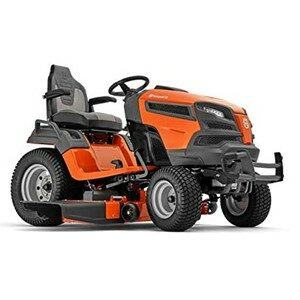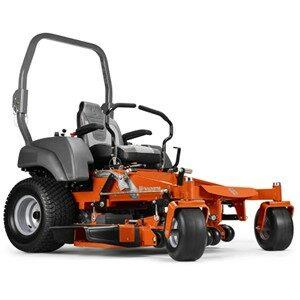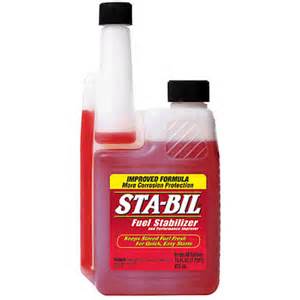Select A Riding Mower For Yard Size & Terrain
1) Matching Mowers with Acres.
2) The Types of Riding Lawn Mowers.
3) Transmissions for Riding Lawn Mowers.
4) Differences Between Riding & Zero-Turn Mowers.
5) Grass Clipping Options.
6) How To Identify Bad Gas.
Introduction
The riding lawn mower buying guide will help those with helpful information when buying a riding lawn mower. You will need to know the size of the yard and the terrain in selecting the right model.
Riding mowers come in gas-powered or battery-powered models. The types of riding mowers are riding and zero-turn. Each type of mower has its own benefits for the size and terrain of the yard.
For example, does your lawn have obstacles to get around? How large is your lawn? Does the yard have slopes to mow over? Each type of mower can mow in these situations better than others.
A zero-turn model is best if your yard has lots of obstacles to avoid when mowing. If you have an uneven type of terrain a regular riding mower with a steering wheel is best. If your yard size is ¾ of an acre or more, a riding mower is recommended.
Do your homework to know your yard size, types of terrain, and obstacles the yard has to which model mower is best.
Matching Mowers with Acres
All lawns are not exactly alike and that is true for the acreage of your yard. The measurements below will help you in selecting the best cutting width riding mower. The acreage breakdown is below by cutting width of the mower.
- ¾ Acre to 1 Acre Lawn: Look for a model that has cutting widths between 30-Inches to 42-Inches.
- 1 Acre to 2 Acres: Look for a model that has cutting widths between 42-inches and 50-inches.
- 2 Acre to 3 Acres: Look for a model that has cutting widths between 50-inches to 54-inches.
- 3 Acres to 5 Acres: Look for a model that has cutting widths between 54-inches to 62-inches.
- 5 Acres or Larger: Look for a model that has cutting widths 60-inches and above.
- Lawns smaller than ¾ Acres: A push mower model is best. You can think about using a self-propelled rear wheel model if the yard size is closer to ¾ acres.
Now that you know the size of your yard, you can focus on the best riding mower. Knowing your landscape terrain will play a role in the selection process.
Types of Riding Lawn Mowers
When you know the yard size and terrain type, now go to the next step and focus on which type of riding mower is best for your yard. There are two types of riding mower models and they are gas and battery powered. Let’s look at them more closely.
Gas Powered Riding Mowers
The gas riding mowers have many models to select from and they all operate on gas to power them. They will vary in size from 30-inch cutting widths to over 60 inches. Depending upon the size of your lawn or property, you can determine the best the cutting width. When making this decision, beware that the larger the cutting width the more costly the lawn mower will be. Your budget might just play a role here. The average prices of these mowers will vary from $2000 to over $7000.
The only other concern is the attachments and features you want on the mower. Models have choices such as mulching, side discharge and bagging. Some models come with all three and some just two of them. Determine which of these features are a necessity for your situation.
As for the features, look at the horsepower, torque, cruise control, wheels, and speeds. Some other nice features would be a cup holder, high back seat, armrests, and leg room if you are tall. Decide on which of these features are a must have.
After deciding on a model that meets your needs, go to the retail store to check them out before committing on purchasing. Sit on the seat to determine if it is comfortable. Ask questions about the warranty and any other concerns you might have about the mower.
The options here are regular riding or zero-turn models.
Tip: Be sure to add a fuel stabilizer into the gas can every time you fill it with fresh gas. A fuel stabilizer will keep the gas fresh for up to 1-year and prevent any gum build-up in the carburetor.
Battery Powered Riding Mowers
Today there are some manufacturers that are now making battery powered lawn mowers which are excellent options for those who are concerned about the environment. They will not pollute the air with gas fumes. If you are concerned about what emissions you are putting into the air when you mow, then look for a battery powered riding mower.
These models mow on battery power. When the battery gets low they must be recharged. This all takes time out of the mowing day. Some riding mower models come with more than one battery to make the mower run time last longer. Most models will run for up to one hour on a full charge. Remember, to use a riding mower your yard must be ¾ of an acre or larger. These models can get expensive. A 42-inch cutting width battery mower averages about $5000.
The battery mowers do have some features and attachments to consider. As with the gas-powered models, you can mulch, side discharge, or bag. Look for these features on the model you must have.
The biggest benefit of these mowers is no oil or gas and the engine runs quieter than the gas models. With the cost of gas today, this can be a huge savings if you have a large area to cut on a regular basis.
These models may have limited choices as to the cutting widths. When you decide on a model, go to the retail store to check them out. Sit in the seat to determine if it’s comfortable. Ask questions about the warranty. Ask about the battery, how long does it take to fully charge and how much runtime it has.
Regardless of which type of mower you chose, gas or battery powered, you must perform the standard maintenance that is described in the owner’s manual. This keeps the mower warranty in force and will extend the life of the mower.
The options here are regular riding or zero-turn riding models.
Transmissions for Riding Lawn Mowers
As you search for the best riding mower, you should become familiar with the transmission types. Let’s talk about them.
- Manual Transmission. This type offers a choice of speeds (gears) that you select from. If you choose this type, we suggest that you look for models that allows you to shift up or down without stopping or using the clutch. For new operators this can be difficult to learn at first.
- Automatic Transmission. This works just like the transmission in your car. The speed is controlled with the gas pedal. Some models come with cruise control allowing you to travel in one speed for long stretches. You can easily change speeds to slow down to go around obstacles in the yard. This is a great choice for operators with little experience on a riding mower.
- Hydrostatic Transmission. This type of transmission is the most common one being used on riding mowers. This works like the automatic transmission, but it uses fluids instead of belts to transfer power from the engine to the wheels. Allows for greater variability in the mower’s forward speed. The benefit of this transmission is that it offers a smoother ride and requires less maintenance.
As you move up from the manual to the hydrostatic transmission you can expect to pay a little more. Your budget will play a vital role in making this decision.
Differences Between Riding & Zero-Turn Models
We should explain the differences between regular riding and zero-turn riding lawn mowers. The main difference between these models is the steering controls.
Zero-Turn Mowers
-
Gives you power to turn around quickly.
- Two steering levers helps you maneuver the lawn better in avoiding obstacles.
- Easy to make 180-degree turns.
- Maximum speed up to 8 MPM.
- Helps in aligning the mower deck with the edge of the previous cut.
- These models are not intended for attachments.
- Less versatility than riding mowers.
- Does not perform well on difficult terrains like hills.
- More expensive than regular riding mowers.
- Requires a learning curve to get used to how it works.
Regular Riding Mowers
- More versatility over zero-turn models.
- Move across the landscape faster than a push model.
- Has more attachments options for other jobs like snow removal, and seeding etc.
- The mower is controlled by a steering wheel just like a car.
- Has maximum speed up to 4 MPH.
- Has some difficulty in moving around obstacles.
- Best for uneven and hilly terrains.
- Less expensive than zero-turn models.
- No learning curve in using these models.
With the information above, you should be able to focus on which of them is best for your lawn condition.
Grass Clipping Options
When mowing the lawn, the mower will dispense the grass clippings in one of three ways: side discharge, mulching or bagging. You must decide on how to take care of the clippings after mowing. When looking at various models, some will say 2-in-1 or 3-in-1. 3 in 1 mowers allow for side discharge, mulching and bagging. 2 in 1 mowers have the options of side discharge and mulch, or bagging and mulching. Decide on which option is best for your situation as each yard or property is not the same.
- Side Discharge Option. This option allows the clippings to be scattered out on the lawn. This is a non-stop operation and allows for faster mowing and a cleaner cut. If the grass is too thick, you may have to rake the clippings after the mowing session and properly dispose of them.
- Bagger Option. With the bag option, as you mow the clippings are collected into the bag. This method keeps the lawn clean and reduces the spread of weed seeds. In the fall it is useful for clearing leaves on the lawn. When the bag gets full, you must stop and empty the bag which results in added time to complete the mowing session. After mowing, you will not have to rake the clippings but you will need to properly dispose them.
- Mulching Option. Some models comes with a mulching kit that turns the clippings into mulch that adds nutrients back into the soil. Mulching is a great option if you mow regularly and the grass is not too tall. The kit may contain mulching blades which cuts the grass into smaller size clippings. This may require you to change the blades when using this option.
- Additional Tip. When you mow, be sure to remove only the top 1/3 of the grass. For example, if the grass is 3 inches tall only remove the top 1 inch. This will result in a better overall lawn look and is healthier too.
How To Identify Bad Gas
You just purchased fresh gas into the gas can for using it with your lawn mower. Now, let’s provide some information on how to tell if the gas you have is old or bad. As gas ages, its chemical properties change.
The normal shelf life of regular gas is from three to six months. Ethanol gas can lose its combustibility in one to three months due to oxidation and evaporation. Diesel fuel has a shelf life of 1-year before it degrades. What you don’t know is how long the gas was sitting at the station before you pumped it into your tank.
Below are some symptoms of stale or bad regular or ethanol gas:
- If you should notice the fuel with a darker or muddier appearance this is a sign the gas is bad.
- It may also have a sour or disagreeable odor that is not typical of fresh gas.
- In some instances people have reported the gas smelling spoiled.
- Beginning to notice engine or starting problems.
If you should notice any of these symptoms, get rid of the old or stale gas.
You can keep gas fresh by adding a fuel stabilizer into the tank or gas can.
Note: If you open a Sta-Bil Storage fuel stabilizer container, it must be used within 2 years as its effectiveness wears off. So, when you open the bottle, note the date somewhere on the container.
Conclusion
We shared some valuable information on riding lawn mowers. Such as lawn size, identifying bad gas, options on grass clippings, and transmissions used for riding mowers.
As you should know, buying a riding mower will be costly, so plan your budget accordingly. Determine ahead of time the width size of the blades and if you want to use a gas-powered or battery-powered model mower. Once you made your decision, go to the retail store to check out the model. Ask questions about the mower until you are satisfied.
Then go to the store that offers you the best deal for the mower. If you should purchase a gas model, don’t forget to buy a fuel stabilizer to extend the life of the fuel to keep it fresh.
Lastly, always perform the standard maintenance as described in the owner’s manual to keep the mower running in top condition. In doing so, you extend the life of the mower and reduce any repair bills in the future, and keep the warranty in force.
Shop Fuel Stabilizers & Engine Treatments
You can shop for the fuel stabilizer or engine treatment below. Just click on any image and you will be taken to Amazon where you can place the order, read customer reviews, and answered questions.
As an Amazon Associate I earn from qualifying purchases.


